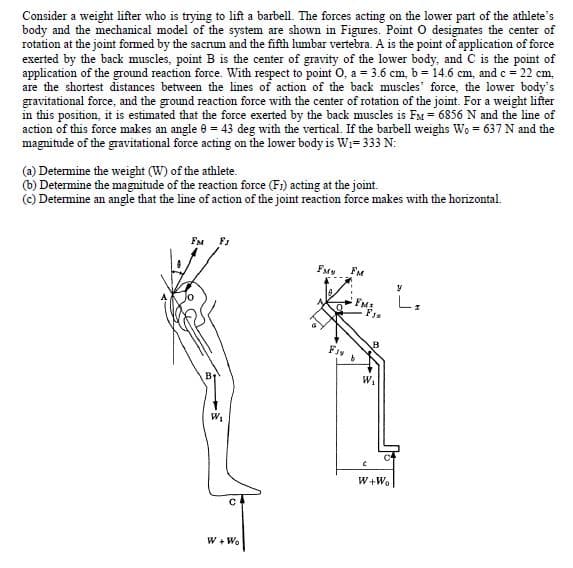Consider a weight lifter who is trying to lift a barbell. The forces acting on the lower part of the athlete's body and the mechanical model of the system are shown in Figures. Point O designates the center of rotation at the joint formed by the sacnum and the fifth lumbar vertebra. A is the point of application of force exerted by the back muscles, point B is the center of gravity of the lower body, and C is the point of application of the ground reaction force. With respect to point O, a = 3.6 cm, b - 14.6 cm, and c= 22 cm, are the shortest distances between the lines of action of the back muscles' force, the lower body's gravitational force, and the ground reaction force with the center of rotation of the joint. For a weight lifer in this position, it is estimated that the force exerted by the back muscles is Fx = 6856 N and the line of action of this force makes an angle e = 43 deg with the vertical. If the barbell weighs Wo 637 N and the magnitude of the gravitational force acting on the lower body is W- 333 N: (a) Determine the weight (W) of the athlete. (b) Determine the magnitude of the reaction force (F1) acting at the joint. (c) Determine an angle that the line of action of the joint reaction force makes with the horizontal.
Consider a weight lifter who is trying to lift a barbell. The forces acting on the lower part of the athlete's body and the mechanical model of the system are shown in Figures. Point O designates the center of rotation at the joint formed by the sacnum and the fifth lumbar vertebra. A is the point of application of force exerted by the back muscles, point B is the center of gravity of the lower body, and C is the point of application of the ground reaction force. With respect to point O, a = 3.6 cm, b - 14.6 cm, and c= 22 cm, are the shortest distances between the lines of action of the back muscles' force, the lower body's gravitational force, and the ground reaction force with the center of rotation of the joint. For a weight lifer in this position, it is estimated that the force exerted by the back muscles is Fx = 6856 N and the line of action of this force makes an angle e = 43 deg with the vertical. If the barbell weighs Wo 637 N and the magnitude of the gravitational force acting on the lower body is W- 333 N: (a) Determine the weight (W) of the athlete. (b) Determine the magnitude of the reaction force (F1) acting at the joint. (c) Determine an angle that the line of action of the joint reaction force makes with the horizontal.
International Edition---engineering Mechanics: Statics, 4th Edition
4th Edition
ISBN:9781305501607
Author:Andrew Pytel And Jaan Kiusalaas
Publisher:Andrew Pytel And Jaan Kiusalaas
Chapter7: Dry Friction
Section: Chapter Questions
Problem 7.78P: The figure shows a steel bar being processed by a rolling mill. Given that P=80kN and r =0.016,...
Related questions
Question
100%
2- Can anyone solve this problem with all steps and F.B.D ? Thanks

Transcribed Image Text:Consider a weight lifter who is trying to lift a barbell. The forces acting on the lower part of the athlete's
body and the mechanical model of the system are shown in Figures. Point O designates the center of
rotation at the joint formed by the sacrum and the fifth lumbar vertebra. A is the point of application of force
exerted by the back muscles, point B is the center of gravity of the lower body, and C is the point of
application of the ground reaction force. With respect to point O, a = 3.6 cm, b = 14.6 cm, and c = 22 cm,
are the shortest distances between the lines of action of the back muscles' force, the lower body's
gravitational force, and the ground reaction force with the center of rotation of the joint. For a weight lifter
in this position, it is estimated that the force exerted by the back muscles is FM = 6856 N and the line of
action of this force makes an angle 0 = 43 deg with the vertical. If the barbell weighs Wo = 637 N and the
magnitude of the gravitational force acting on the lower body is W:= 333 N:
(a) Determine the weight (W) of the athlete.
(b) Determine the magnitude of the reaction force (F;) acting at the joint.
(c) Determine an angle that the line of action of the joint reaction force makes with the horizontal.
FM
Fty
FM
FMS
L,
B
W.
W+W.
W + Wo
Expert Solution
This question has been solved!
Explore an expertly crafted, step-by-step solution for a thorough understanding of key concepts.
This is a popular solution!
Trending now
This is a popular solution!
Step by step
Solved in 6 steps with 6 images

Knowledge Booster
Learn more about
Need a deep-dive on the concept behind this application? Look no further. Learn more about this topic, mechanical-engineering and related others by exploring similar questions and additional content below.Recommended textbooks for you

International Edition---engineering Mechanics: St…
Mechanical Engineering
ISBN:
9781305501607
Author:
Andrew Pytel And Jaan Kiusalaas
Publisher:
CENGAGE L

International Edition---engineering Mechanics: St…
Mechanical Engineering
ISBN:
9781305501607
Author:
Andrew Pytel And Jaan Kiusalaas
Publisher:
CENGAGE L